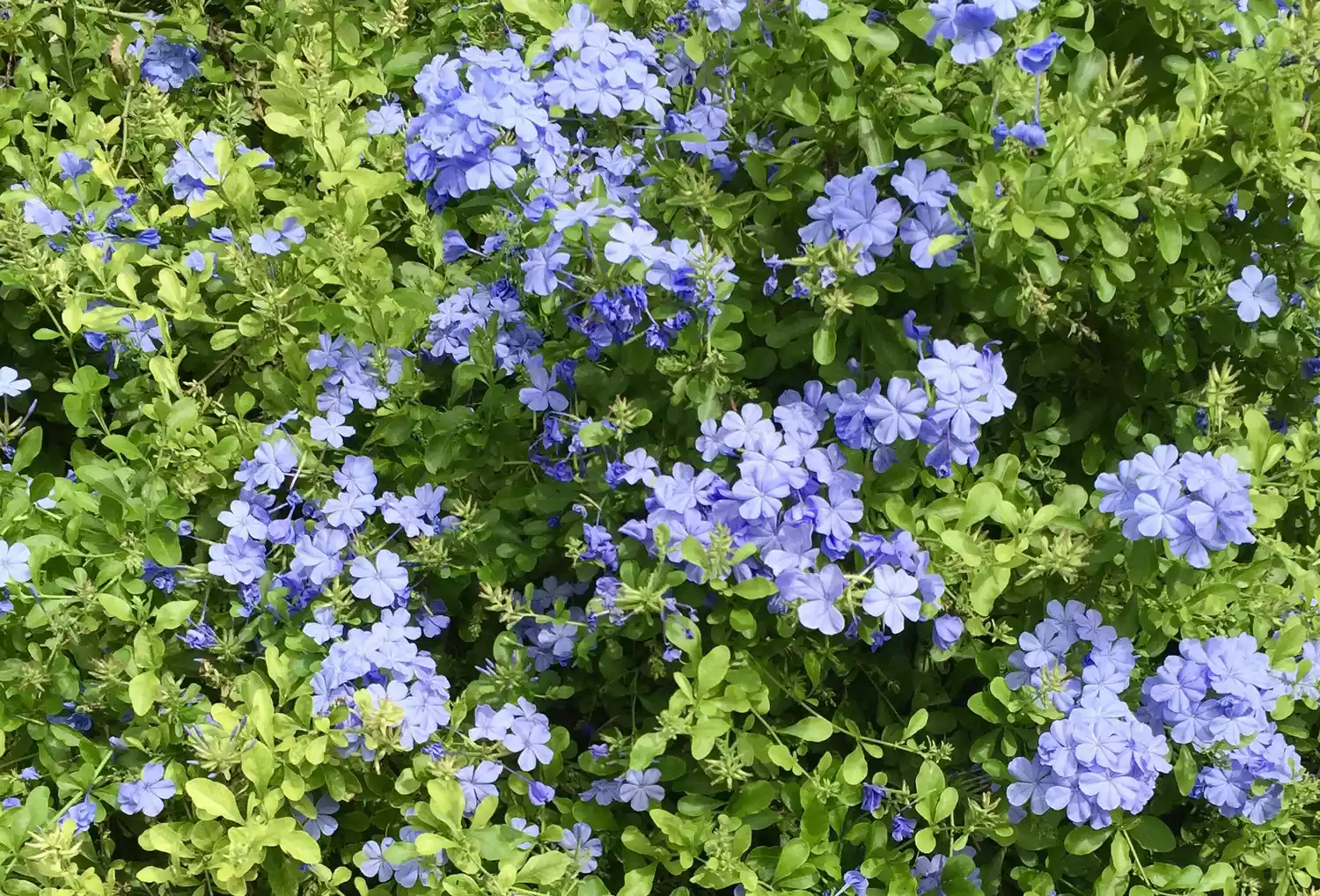
Characterized by warm to hot temperatures and a long growing season, USDA Zone 8 includes the Lower South and affords almost year-round opportunities for gardening. It is one of the warmest zones in the United States. Enjoying typically mild winters, some Zone 8 plants experience multiple blooming and fruiting seasons. These perennials, evergreens, vines, shrubs, and trees will thrive in your Zone 8 garden.
Perennial: Esperanza
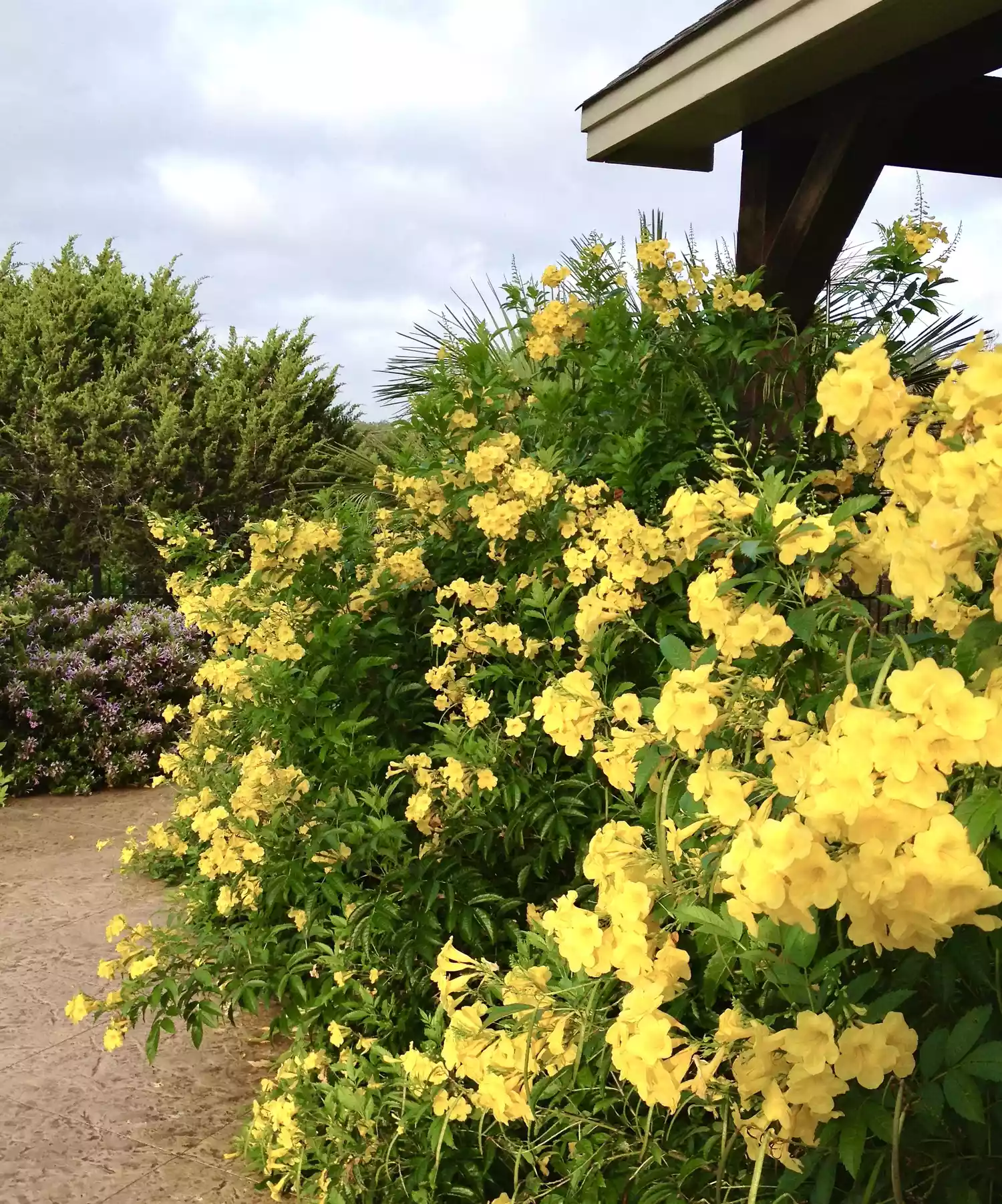
(Tecoma stans)
Esperanza, Spanish for ‘hope,’ blooms prolifically from spring through fall in Zone 8. Also known as yellow bells, this showstopper grows 6 to 8 feet tall and 4 feet wide and comes back reliably year after year. This medium-sized shrub is xeric, low maintenance, and relatively pest free. It thrives in hot sun and tolerates a variety of soils, particularly alkaline limestone. After dormancy cutback, Esperanza shoots up quickly when weather warms. Tecoma stans comes in other colors as well, including reddish orange ‘Bells of Fire,’ tangerine ‘Orange Jubilee,’ and a brighter, more compact yellow, ‘Lydia.’ They are popular with pollinators, bees, and hummingbirds.
USDA Growing Zones: 8-11
Bloom/Foliage Color: Yellow, red, orange
Light Requirements: Full sun
Soil Requirements: Loam, sandy, clay
Water Requirements: Low to moderate, drought-tolerant once established
Perennial: Salvia
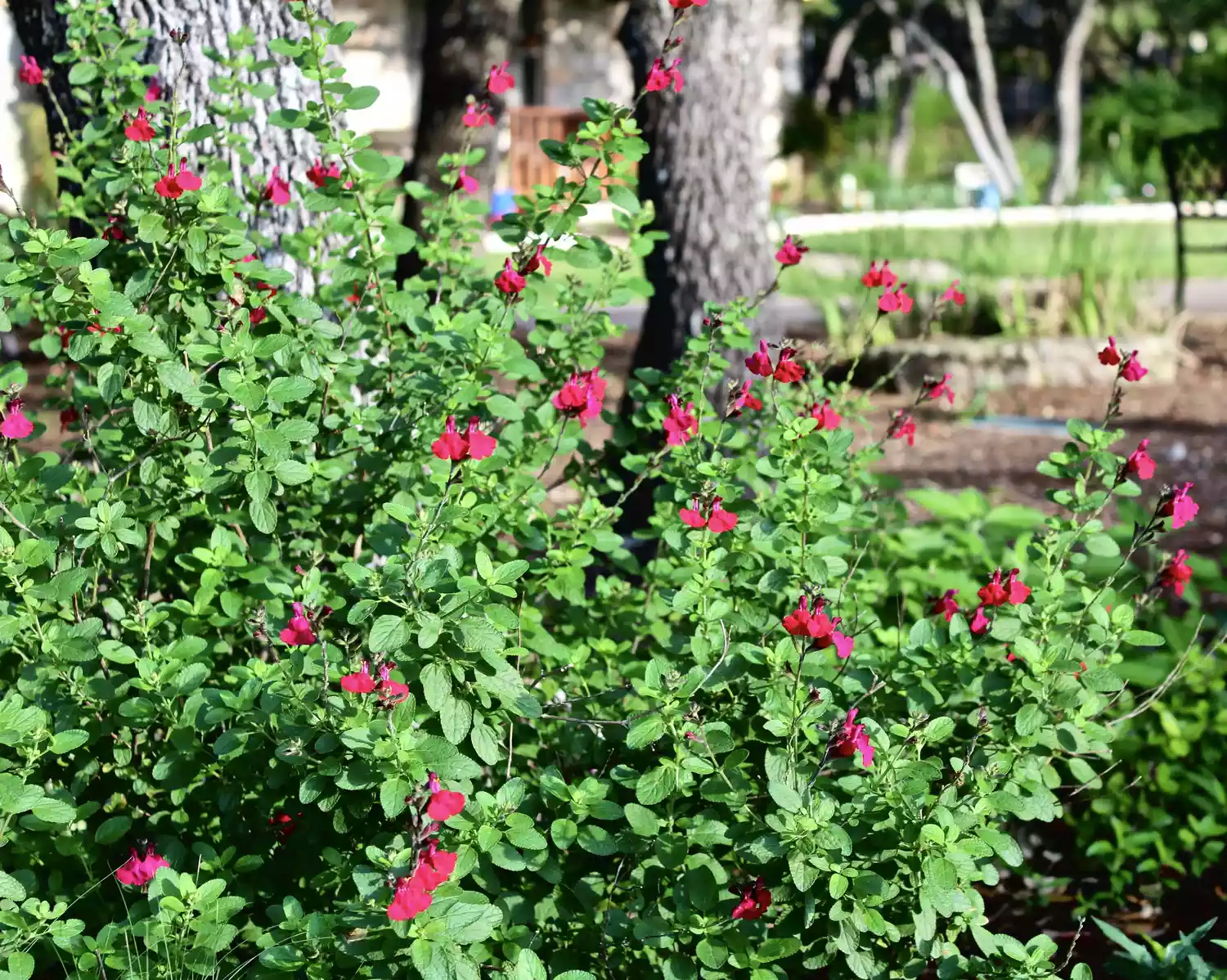
Salvias, staples of Lower South gardens, come in every size and color imaginable, with more than 900 species to choose from worldwide. Salvia is the largest genus of plants in the mint family. These plants are categorized as evergreen shrubs, herbaceous perennials, and annuals. One of the most common go-to-salvias, Autumn Sage (Salvia Greggii), is an evergreen sub shrub with blooms in shades of red to fuchsia and purple. This salvia graces countless Lower South gardens, growing 2 to 3 feet tall and wide. Other salvias range from 18 inches tall to 5 feet tall with varieties for both sun and shade.
USDA Growing Zones: 5-9
Bloom/Foliage Color: Pink, red purple, blue, orange, white, yellow
Light Requirements: Most salvias like full sun, there are also shade varieties
Soil Requirements: Well-drained soil
Water Requirements: Drought-tolerant once established
Perennial: Zexmenia
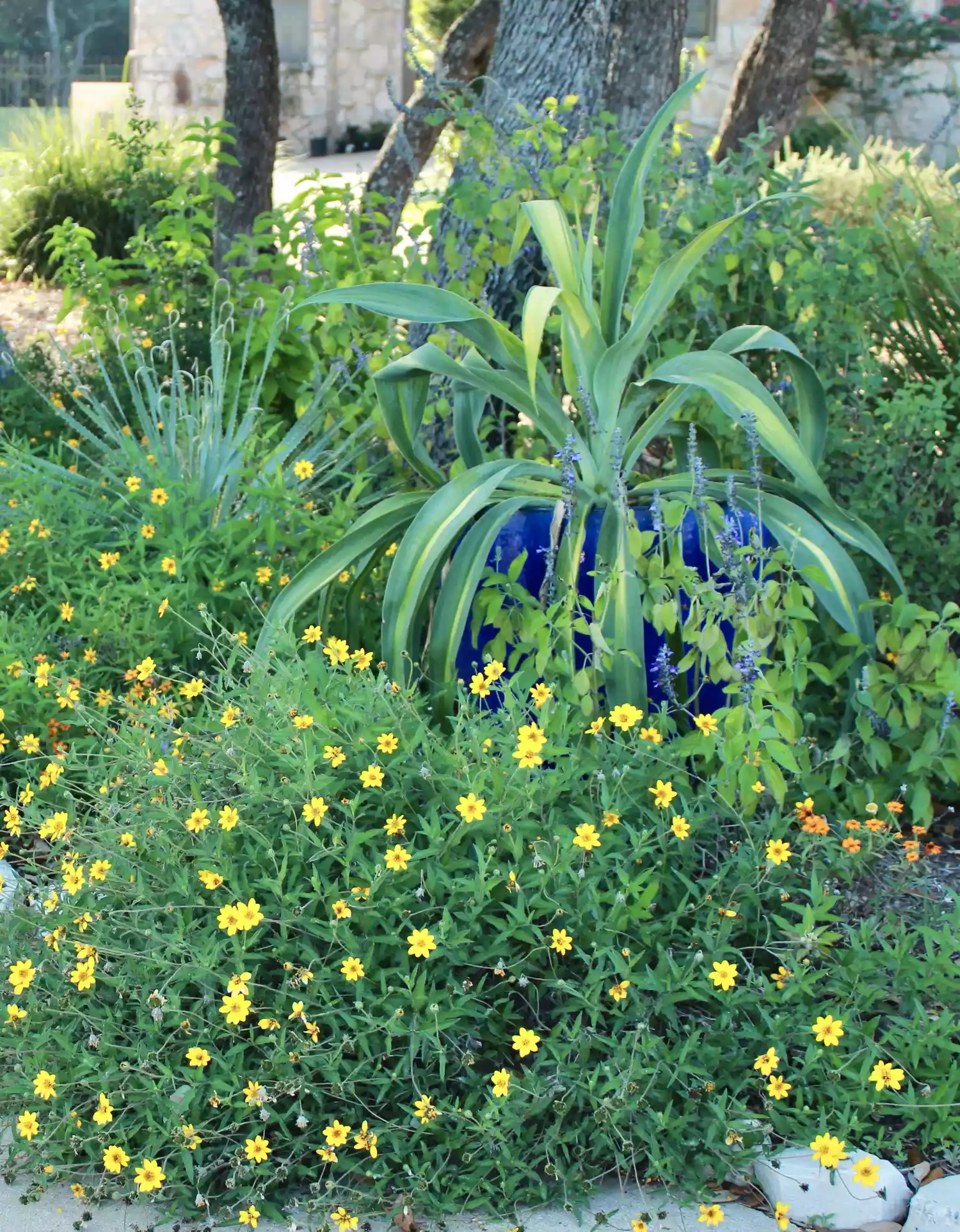
(Wedelia hispida, W. acapulcensis var. hispida, Zexmenia hispida)
Zexmenia is a stellar garden performer, even in the hottest, driest summer conditions and the rockiest soils. A root-hardy perennial, it returns consistently each spring, blooming from summer through fall. This mounding plant sports perky, yellow daisy-like flowers and reaches approximately 2 feet tall and 2-3 feet wide. Pollinators are drawn to this prolific bloomer. The rough, hairy gray-green leaves make Zexmenia deer resistant. Cut back by half in July to encourage another flush of fall flowering.
USDA Growing Zones: 8-11
Bloom/Foliage Color: Yellow
Light Requirements: Full sun, part shade
Soil Requirements: Tolerates many soils
Water Requirements: Drought-tolerant
Perennial: Catmint
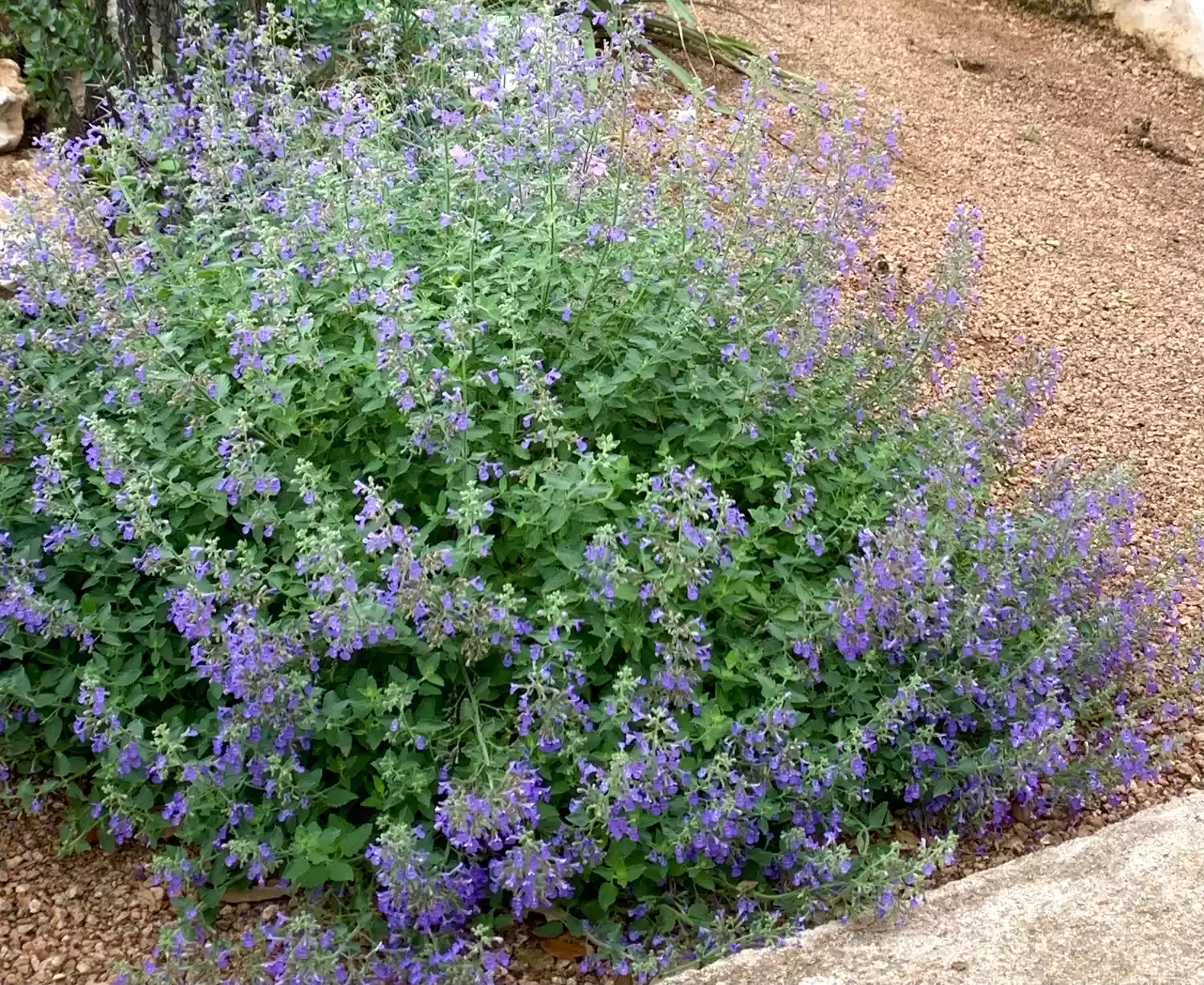
(Nepeta)
Few perennials can compare to the long-lasting, showstopping blooms of catmint. This dynamo packs a pale purple punch from late spring into early fall. Its compact, mounding form is tailor-made for borders, pathways, and rock gardens. Cousin to the feline favorite catnip, this herbaceous perennial grows 6 to 12 inches tall by 12 to 36 inches wide. Flowers grow along the stems in whorls, enveloping almost the entire plant in blooms. Its minty, fuzzy, gray-green leaves make it rabbit and deer resistant. It is heat- and drought-tolerant and requires little to no care once planted. Deadheading or shearing mid-summer will encourage a bushier plant and more blooms.
USDA Growing Zones: 3-8
Bloom/Foliage Color: purple, white, lavender
Light Requirements: Full sun, part shade
Soil Requirements: Well-drained, grows in clay, loam, sandy, or rocky soil
Water Requirements: Low to moderate
Perennial: Lion’s Tail
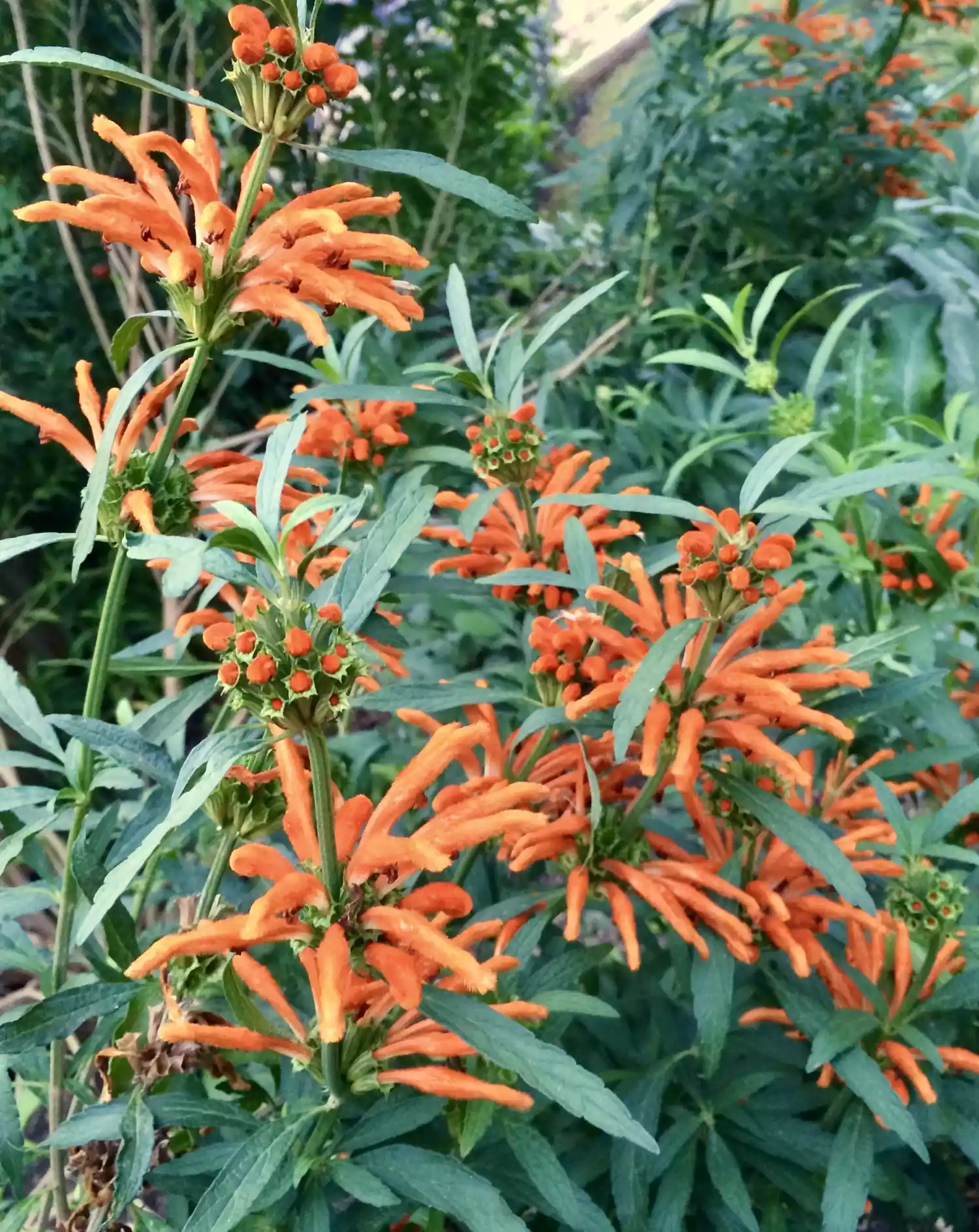
(Leonotis leonurus)
Native to South Africa, Lion’s Tail could vie for the King of the Garden title, with its striking blooms and majestic form. With brilliant orange flowers that grow on upright stems, the tiered tufts are reminiscent of lion’s tails. The fuzzy tubular blooms are also hummingbird and pollinator magnets. This exotic, late summer to early fall specimen keeps the garden glowing when summer bloomers start to fade. Its tall, striking stems filled with flowers also make stunning focal points for floral arrangements. Lion’s Tail is a semi-evergreen perennial that grows 4 to 6 feet tall and 4 to 6 feet wide. It is also used as an herb used to treat a variety of medical conditions including headaches, fevers, coughs among others.
USDA Growing Zones: 8-11
Bloom/Foliage Color: Orange
Light Requirements: Full sun
Soil Requirements: Well-drained, loam, sandy
Water Requirements: Low to Moderate
Perennial: Mexican Oregano
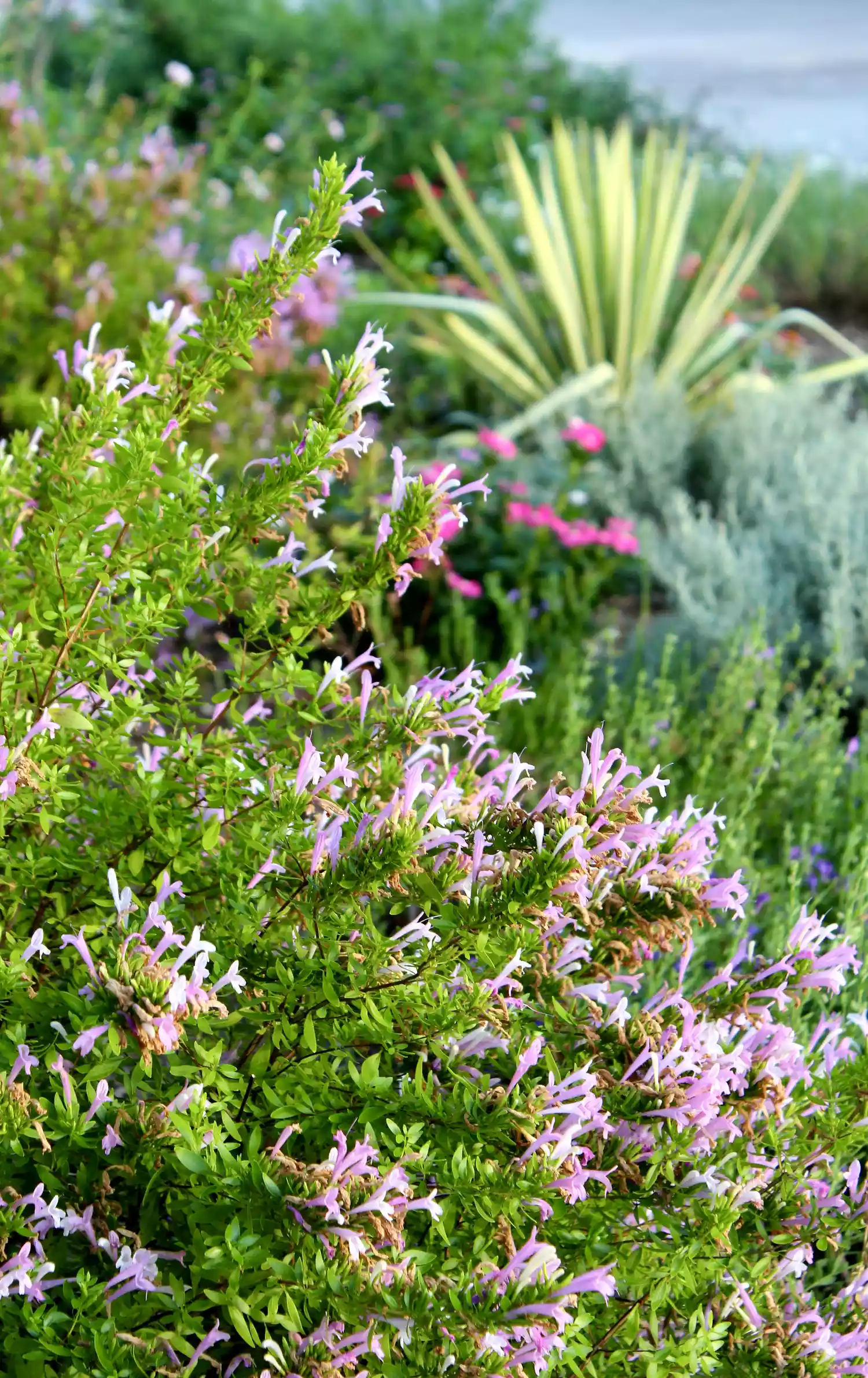
(Lippia gravolens)
Showy, tough-as-nails Mexican oregano blooms through three seasons, from March to November. Producing prolific pale lavender blooms, this xeric native to Mexico provides nectar for bees, butterflies, and other insects. It is highly aromatic, and birds are drawn to its seeds.
A woody evergreen shrub in Zones 8 and higher, this heat- and drought-tolerant plant grows up to 6 feet tall and 3 to 6 feet wide. The multi-stemmed, rounded growth habit makes it a tidy addition to hot gardens, offering a soft contrast to more sculptural plants. Different than the mint family oregano used in Mediterranean food, Mexican oregano belongs to the verbena family. It is slightly sweet with a hint of licorice and brighter citrus notes than traditional oregano.
USDA Growing Zones: 7-11
Bloom/Foliage Color: Lavender
Light Requirements: Full sun, part shade, but will bloom less
Soil Requirements: Well-drained, tolerates rocky, caliche, gravel, sand, clay, and loam
Water Requirements: Low, drought-tolerant
Perennial: Plumbago
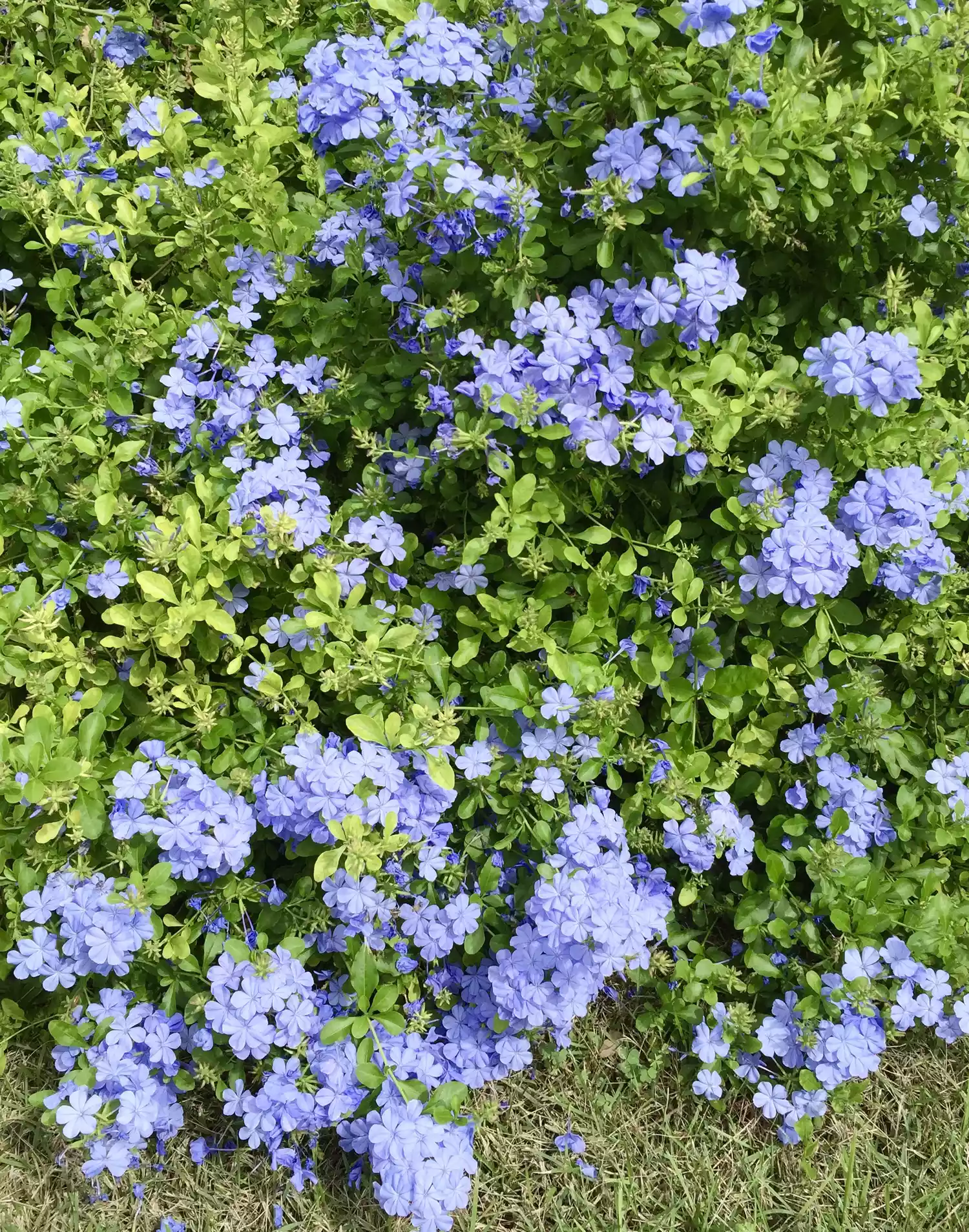
(P. auriculata, P. capensis)
Designing a garden with a blue color palette is challenging. True blue flowers are scarce in the plant world and as such are prized by gardeners. Cape Plumbago, with its dramatic arching branches, blooms profusely with blue, phlox-like flowers from May to October. White and several shades of blue blooms are available, including varieties ‘Imperial,’ and ‘Escapade,’ that range from a light blue to cornflower blue. It grows in sprawling clumps that spread through rhizomes. Native to South Africa, this robust blooming perennial typically grows 3 to 4 feet tall and 3 to 5 feet wide. Bountiful Plumbago pairs well with coral- and tangerine-colored plants across from blues on the color wheel.
USDA Growing Zones: 8-11
Bloom/Foliage Color: White, Periwinkle blue, Light blue
Light Requirements: Full sun, part sun
Soil Requirements: Acid, neutral or alkaline, well-drained
Water Requirements: Drought-tolerant once established
Perennial: Pink Skullcap
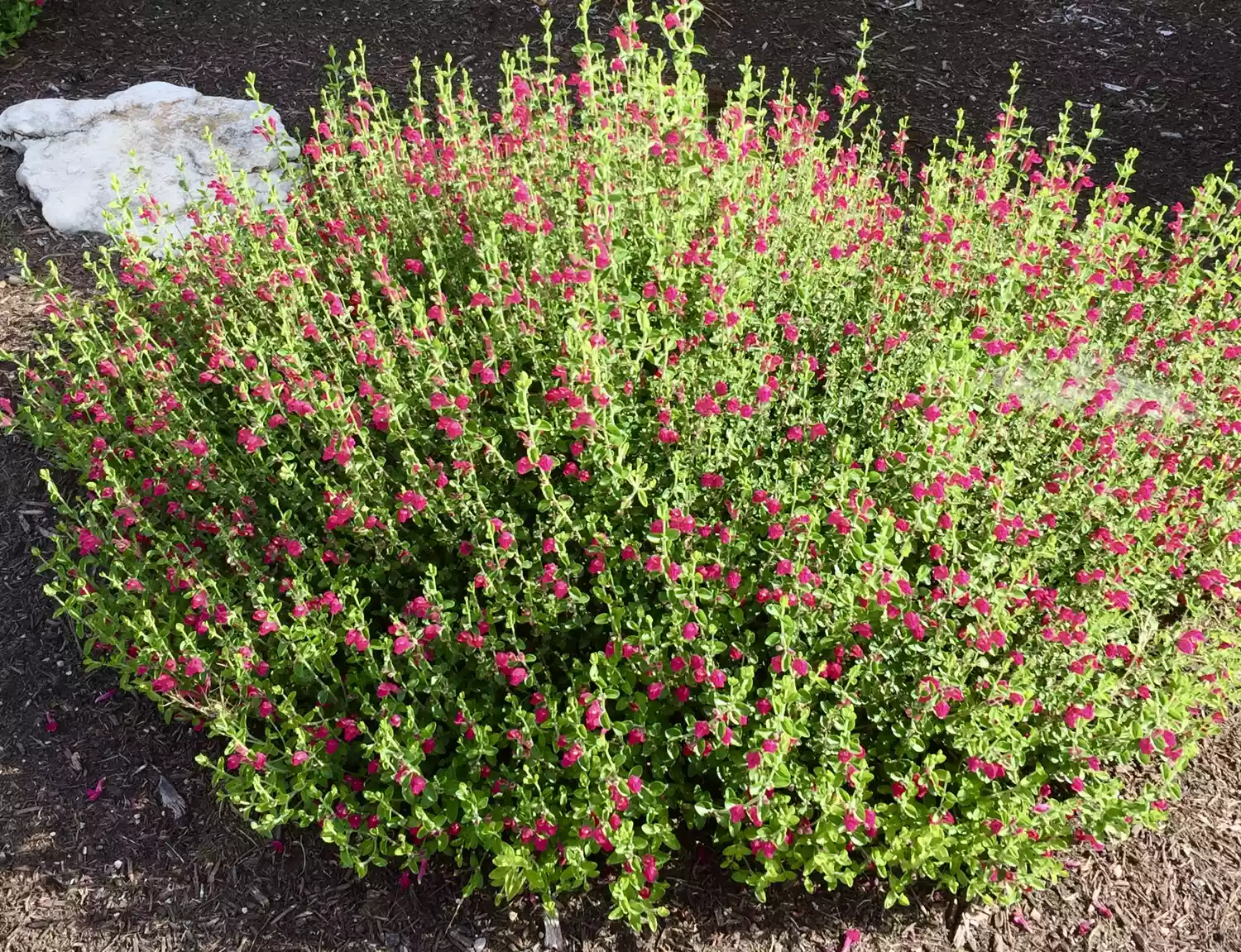
(Scutellaria suffretescens)
Amp up the wow factor in your layered garden with a border of pink skullcap. This woody, herbaceous perennial blooms continuously from late spring to early fall. With snapdragon-like tubular flowers, gray-green leaves and a tidy, low mounding habit, skullcap makes an attractive addition to borders, rock gardens, or sloping hillsides. Part of the mint family, skullcap is heat- and drought-tolerant, and disease and pest resistant. It grows from 1.5 feet tall and 2-3 feet wide, fitting for xeric mass plantings or a dense, spreading groundcover. Depending on the location, it can remain semi-evergreen in winter. A Mexico native, shear back in early spring to shape and encourage more profuse blooms.
USDA Growing Zones: 7-10
Bloom/Foliage Color: Pink
Light Requirements: Full sun, part shade
Soil Requirements: Well-draining
Water Requirements: Low, medium
Perennial: Ruby Crystal Grass

(Melinis nerviglumis)
While beautiful blooms often get top billing in gardens, stunning grasses like Ruby Crystal add an unparalleled design element. Its soft, billowy texture provides dimension to the landscape and creates delicate contrast for sculptural plants. Ruby Crystal grows 18 to 24 inches tall and 16 to 16 inches wide in eye-catching clumps. In summer, the neat mounds of gray-green foliage give rise to fuzzy, pink panicles. The shimmering ruby inflorescence adds rhythm and movement, to the garden. Plant in lines along a path or bordering a bed, or plant in masses to create more impact. In late summer to early fall, the panicles begin to turn silvery white, catching the light as they wave in the breeze. Ruby Crystal also makes an interesting addition to cut and dried flower arrangements.
USDA Growing Zones: 8-10
Bloom/Foliage Color: Ruby pink, rose/gray green
Light Requirements: Full sun
Soil Requirements: Well-drained
Water Requirements: Drought-tolerant to low
Shrub: Distylium
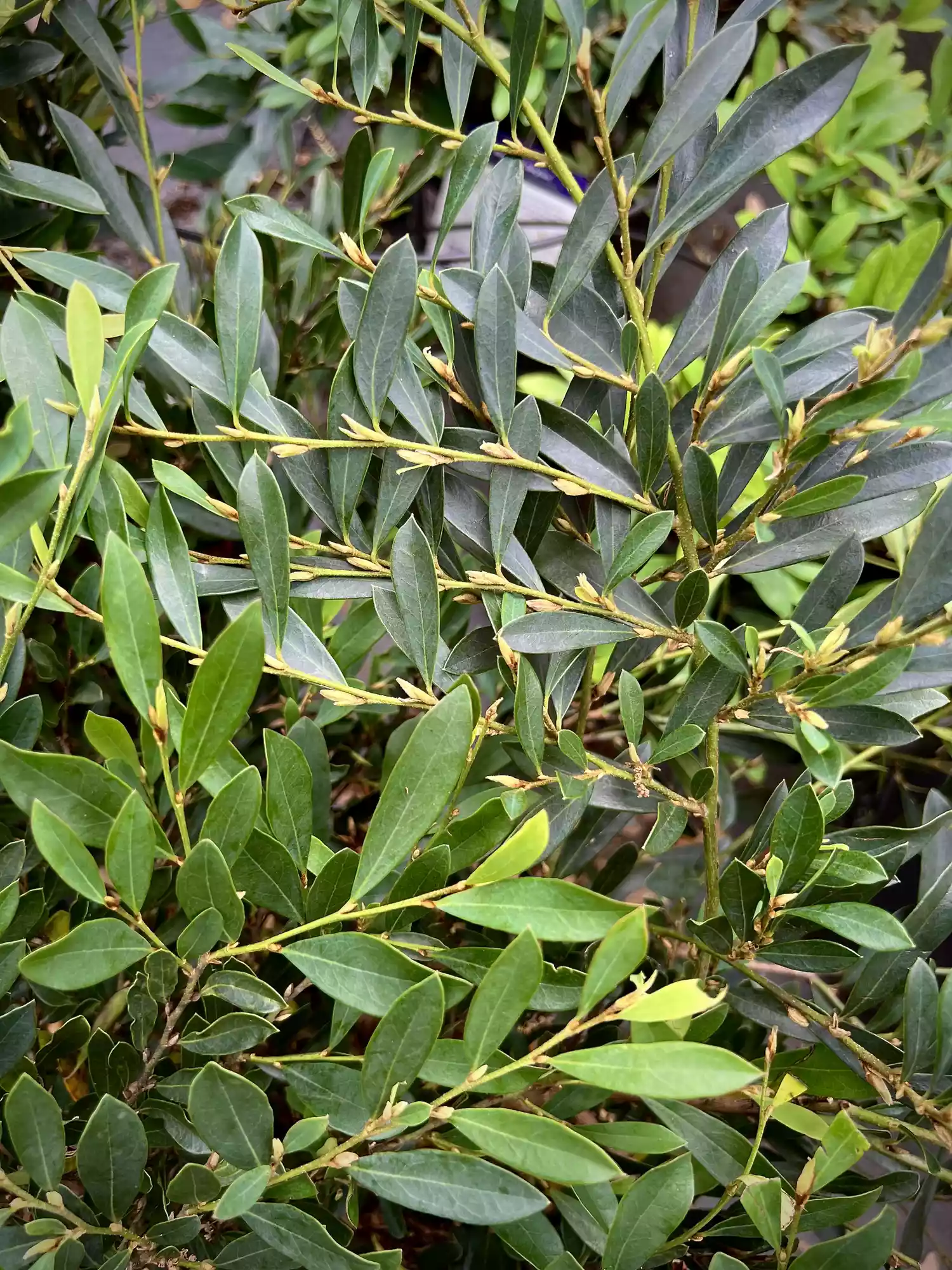
(Hamamelidaceae)
A powerhouse evergreen, Distylium is a versatile, low-maintenance shrub suitable for foundation plantings, borders, and hedges. Its fine texture and dense, tumbling growth habit are excellent alternatives to hollies, boxwoods, or junipers. Distylium provides winter interest, sporting small maroon blooms from January until March. The foliage ranges from glossy blue green to coppery bronze, depending on the variety. Naturally compact, Distylium will hold its shape when planted in the sun. Lightly tip prune in summer to encourage new growth. Will have a more flowing shape in shady conditions. Disease-, pest-, and deer-resistant, this shrub can take the heat and performs reliably in drought situations. Native to Asia, variety sizes range from 2 feet tall to 3 feet wide to up 10 feet tall and 8 feet wide.
USDA Growing Zones: 6-9
Bloom/Foliage Color: Maroon blooms, blue green, copper
Light Requirements: Light shade to full sun
Soil Requirements: Tolerates most well-draining soil, clay, loam, sand
Water Requirements: Drought-tolerant once established
Shrub: Wax Myrtle

(Morella cerifera)
Wax Myrtle, one of the fastest growing large shrubs available, provides a striking screen for privacy, foundation plantings, and property borders. This evergreen shrub can grow as fast as 3 to 5 feet a year, in optimal conditions. It is available in dwarf and full-size and can make an attractive small tree when pruned to create fewer trunks and a raised canopy. Bees and butterflies are drawn to highly fragrant March and April blooms produced by female plants. From fall through winter, the flowers are followed by weeping clusters of 2 – 3 mm dusty blue berries prized by birds. Male plants are required nearby for pollination of females to occur. For coastal areas, Wax Myrtles are also wind and salt tolerant.
USDA Growing Zones: 7-10
Bloom/Foliage Color: Olive green with lime-colored new growth
Light Requirements: Sun, part shade
Soil Requirements: Moist, sand, loam, clay
Water Requirements: Moderate to establish, then drought-and flood-tolerant
Shrub: Dwarf Yaupon Holly
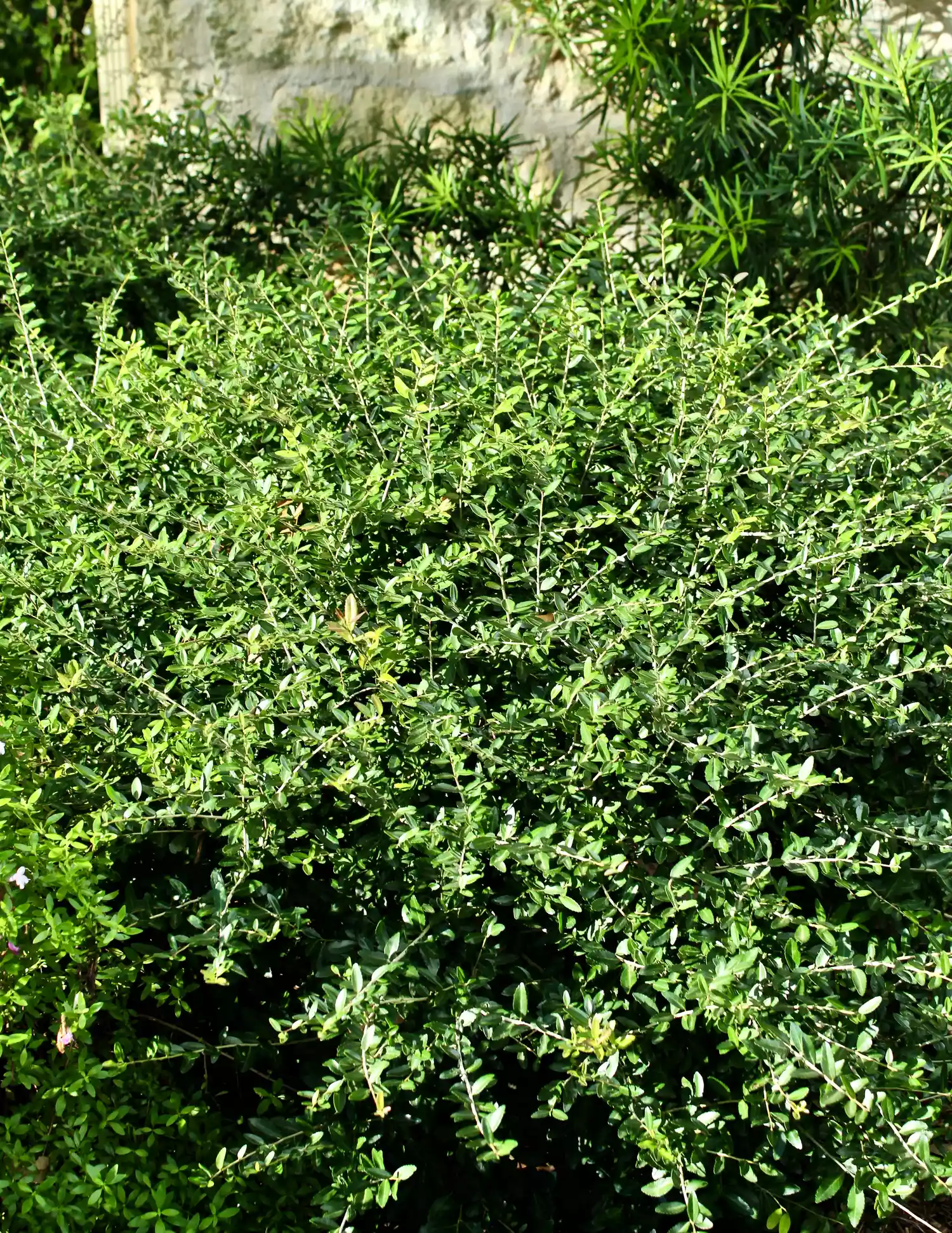
(Ilex Vomitoria)
A mounded evergreen shrub, dwarf yaupon holly supplies superior structure in the garden. This dense and bushy shrub requires little to no maintenance. Its natural, globe-like form makes it a preferred choice for manicured or formal garden styles. Used for foundation plantings, low hedges, or sculptural elements, it sports tiny white blooms from spring to early summer. If the planting includes both male and female plants required for cross pollination, dwarf yaupon will also produce bright red berries that attract birds. Yaupon’s small, dark shiny leaves a finely textured. This broadleaf evergreen grows to 2 to 4 feet tall and 4 to 5 feet wide. For a tidy evergreen patio addition, it can also be grown in pots.
USDA Growing Zones: 7-10
Bloom/Foliage Color: Tiny white flowers, green foliage, red berries
Light Requirements: Full sun to part shade
Soil Requirements: Well-drained, adaptable to most soils
Water Requirements: Low, Heat- and drought-resistant
Vine: Coral Honeysuckle
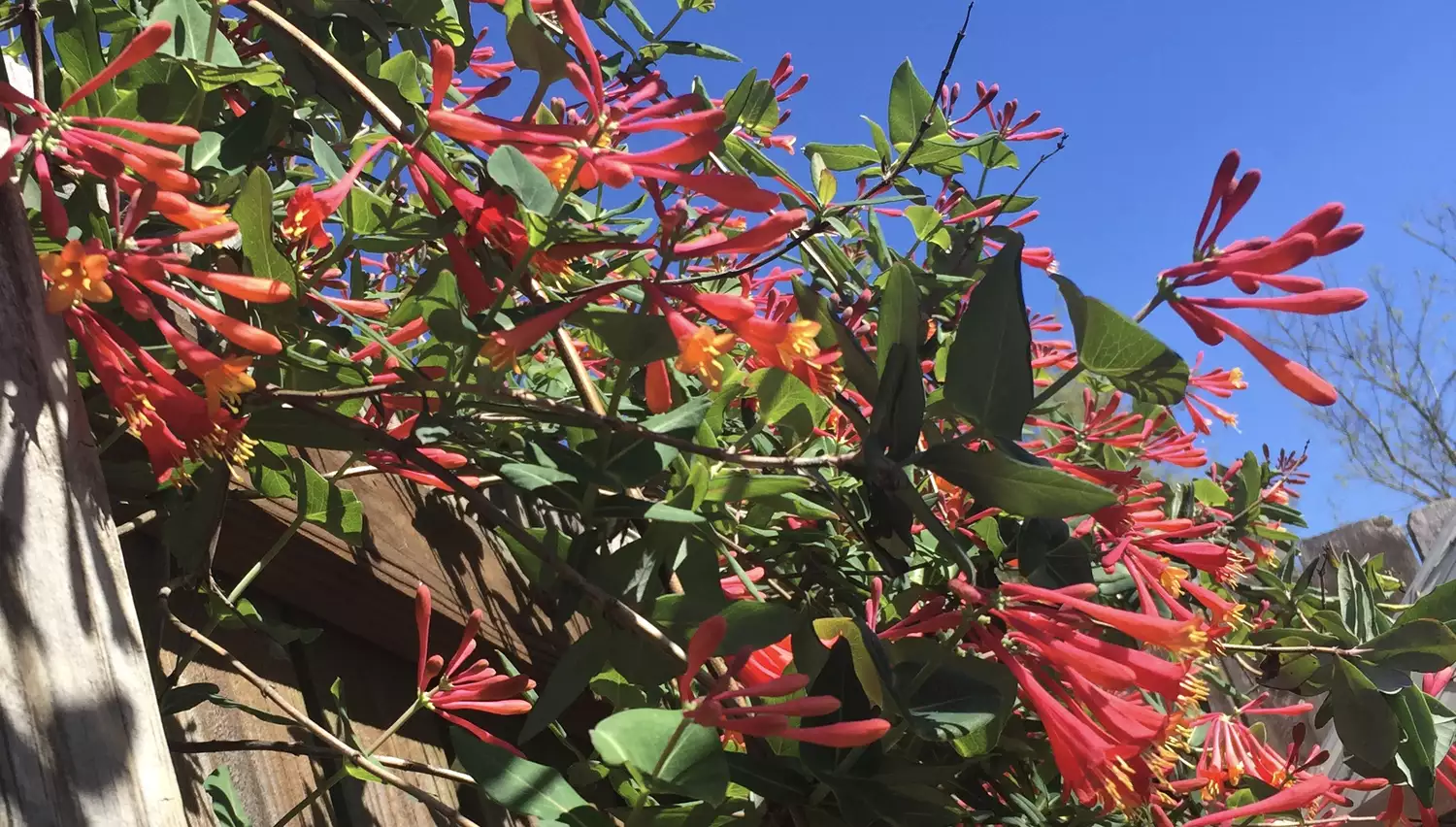
(Lonicera sempervirens)
A profuse bloomer, Coral Honeysuckle is an adaptable, low-maintenance vine without the overwhelming tendencies of its invasive Japanese relative. This woody twining vine yields tubular-shaped flowers in red and coral with yellow to orange throats. It blooms from spring to fall, attracting hummingbirds and butterflies. From summer to fall, it produces bright red berries enjoyed by songbirds. Evergreen in warm climates, it grows 15 to 25 feet tall and 15 to 25 feet wide. Give it a fence, trellis, or arbor and this twining vine will reward you with a vigorous vertical focal point to enjoy through three seasons. Coral honeysuckle is disease and deer resistant.
USDA Growing Zones: 4-10
Bloom/Foliage Color: Coral, red, yellow
Light Requirements: Full sun, part shade
Soil Requirements: Well-drained, adaptable to loam, sand, clay
Water Requirements: Low to medium, drought-tolerant
Tree: Anacacho Orchid
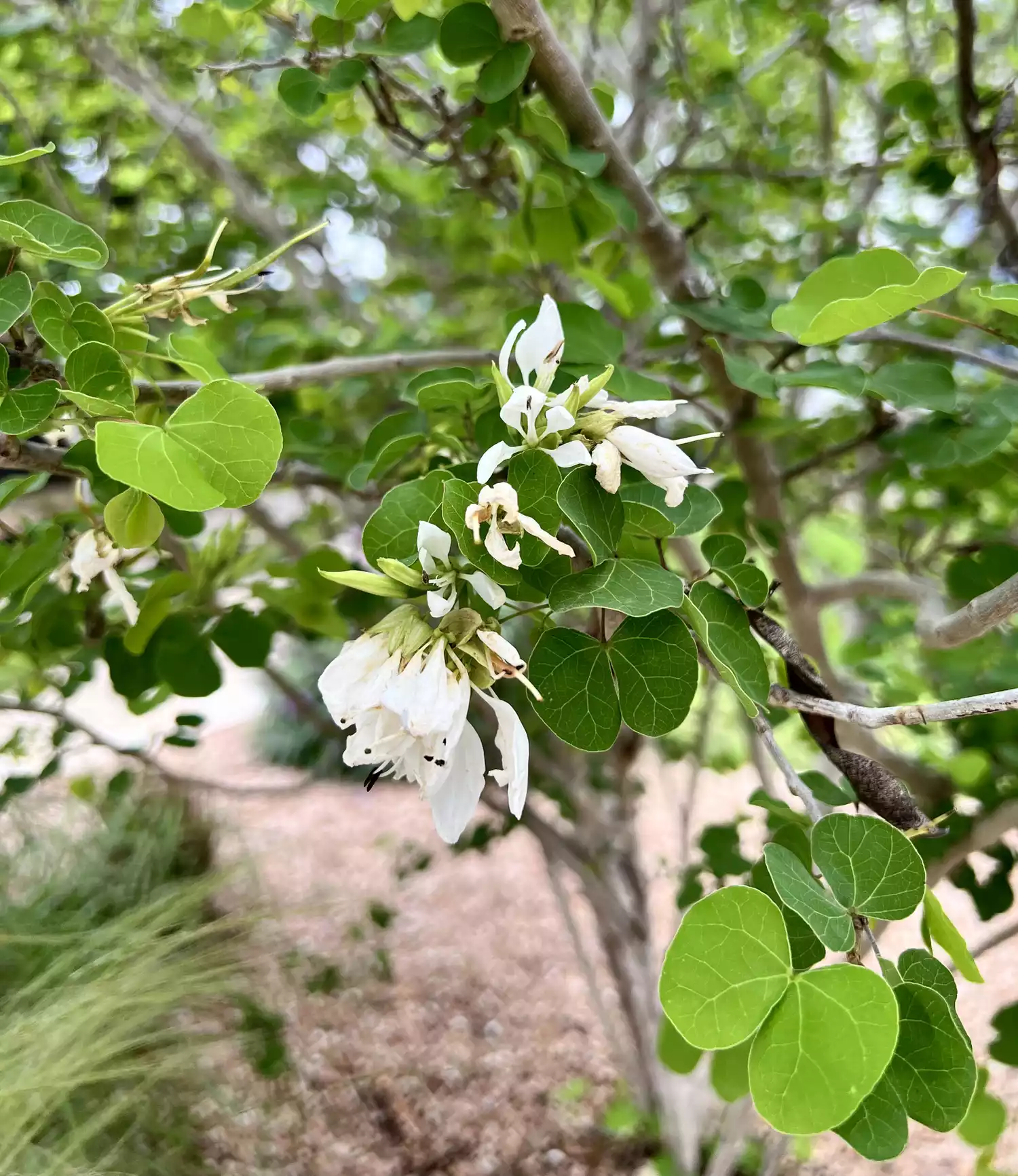
(Bauhinia lunariodes)
The Anacacho orchid tree makes a beautiful specimen plant in the landscape. With white or pink blooms, its silvery gray bark provides interesting structure when this deciduous tree loses its leaves. Delicate, fragrant flowers cover the tree from March through May, attracting bees, butterflies, and birds. Fortunately, deer seem to leave it alone. It’s suitable as a medium shrub, large shrub, or a small, understory tree, depending on pruning style. Its natural shape is shrub-like but is often pruned into vase-like form by selecting fewer trunks and raising the canopy. Native to northeastern Mexico and Texas, it thrives in lean, dry soils in southern states from Florida to Texas. An excellent xeriscape specimen plant, Anacacho orchid grows 6 to 12 feet tall and 6 to 12 feet wide. Exposure to severe cold can damage this small tree/large shrub. Place in a protected area or on the south side if it will be subject to harsh winds or extreme cold conditions.
USDA Growing Zones: 8-11
Bloom/Foliage Color: White, Pink
Light Requirements: Part sun to part shade
Soil Requirements: Well-drained, sand, limestone
Water Requirements: Low, drought-tolerant once established
Succulent
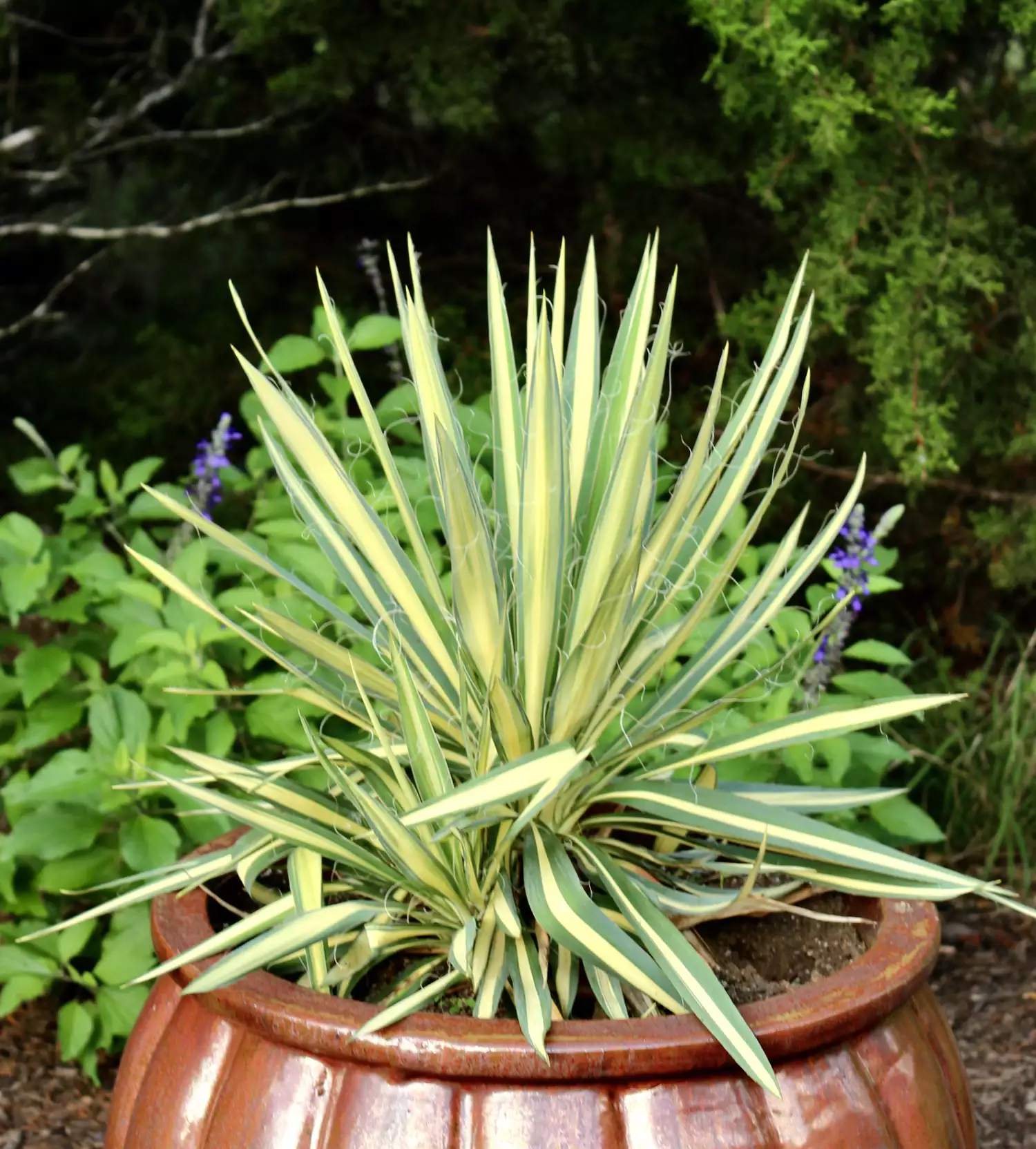
(Yucca filamentosa ‘Bright edge’)
This colorful, clump-forming evergreen reaches 2 feet tall to 4 feet wide with fragrant bloom spikes up to 5 feet tall. It provides structure and texture to add interest in the garden. Its green leaves and bright yellow edges pair well with more delicate plants and flowing forms. It can also be used as a container plant. It doesn’t typically begin blooming until the plant is mature, blooming in June and July. Mature plants also spread by pups that can be dug up and planted in other locations. Bright edge yucca attracts pollinators and hummingbirds and is deer and rabbit resistant.





